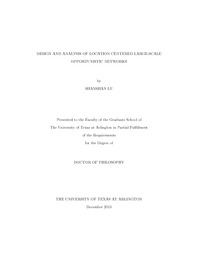
ATTENTION: The works hosted here are being migrated to a new repository that will consolidate resources, improve discoverability, and better show UTA's research impact on the global community. We will update authors as the migration progresses. Please see MavMatrix for more information.
Show simple item record
| dc.contributor.author | Lu, Shanshan | en_US |
| dc.date.accessioned | 2014-03-12T23:52:06Z | |
| dc.date.available | 2014-03-12T23:52:06Z | |
| dc.date.issued | 2014-03-12 | |
| dc.date.submitted | January 2013 | en_US |
| dc.identifier.other | DISS-12439 | en_US |
| dc.identifier.uri | http://hdl.handle.net/10106/24147 | |
| dc.description.abstract | With the high penetration of mobile devices and their equipments of wireless interfaces in people's lives, the development of the scenario of Opportunistic Networks(OppNets) has become available. OppNets enable transmissions by exploiting temporary wireless links and connections opportunistically arising from mobility nature of nodes. The applications of OppNets have emerged in a wide range of areas.OppNets have attracted a lot of attention from the wireless and mobile network research community, while little has been paid to the OppNets in large-scale scenario. The existing OppNets are not scaled well to large-scale area due to the high uncertainty embedded in transient contacts among people on the move. This dissertation introduces the large-scale opportunistic network that is centered and linked by populous locations in a physically large network field instead of transient contacts among mobile nodes. The relative stationary of mobile devices within these locations creates stabler and longer contact opportunities compared to those during movement and therefore provides much higher chances for successful message exchanges, potentially larger network capacity, and more flexibility for application design. A two-layer architecture for the location centered large-scale opportunistic network is proposed in this dissertation. The base layer handles connection and enables device discovery and connection establishment within a location. The upper layer deals with routing which delivers messages to targeted locations and nodes.For location targeted routing, two routing schemes, <italic>LOcation based routing for OPportunistic networks</italic> termed LOOP and <italic>GEOcasting for OPPortunistic networks</italic> termed Geoopp are proposed. Both adapt geographic greedy routing and fit it in the context of large-scale OppNets. The challenge lies in determining the future locations of nodes. LOOP and Geoopp differ in the determination. LOOP constructs a Bayes' predictive model to explore a node's mobility history and learn its mobility pattern, the regularity embedded in its movement. Instead of complicated data mining in LOOP, Geeopp offers a simple yet efficient way to learn the regularity in a novel approach. Geoopp introduces the concepts of inter-visiting time and contact availability per visiting to characterize a node's mobility. Chebyshev's inequality is employed to capture the regularity embedded in node mobility from visit and contact perspectives.For node targeted routing, a <italic>CAlendar based RouTing scheme</italic> termed CART is proposed. While most existing routing schemes infer node mobility from context and social information, including LOOP and Geoopp which infer future locations from previous trajectory, CART studies a novel direction to obtain mobility without inference. CART explores the online public calendars for acquiring reliable node mobility and more importantly a global view of the evolving network topology. At the source node, CART can discover a path connecting source node and destination node, a node sequence from source to destination where pair of adjacent nodes share overlapped time and location. The message will be forwarded over the predetermined path.For the connection layer, a device discovery approach and connection establishment scheme using ad-hoc Wi-Fi is proposed in this dissertation. It discovers devices within a larger range compared to commonly used Bluetooth and therefore enables the longer and stabler connections among mobile nodes inside a location. This approach is further enhanced with energy efficiency. | en_US |
| dc.description.sponsorship | Liu, Yonghe | en_US |
| dc.language.iso | en | en_US |
| dc.publisher | Computer Science & Engineering | en_US |
| dc.title | Design And Analysis Of Location Centered Large-scale Opportunistic Networks | en_US |
| dc.type | Ph.D. | en_US |
| dc.contributor.committeeChair | Liu, Yonghe | en_US |
| dc.degree.department | Computer Science & Engineering | en_US |
| dc.degree.discipline | Computer Science & Engineering | en_US |
| dc.degree.grantor | University of Texas at Arlington | en_US |
| dc.degree.level | doctoral | en_US |
| dc.degree.name | Ph.D. | en_US |
Files in this item
- Name:
- Lu_uta_2502D_12439.pdf
- Size:
- 398.7Kb
- Format:
- PDF
This item appears in the following Collection(s)
Show simple item record


